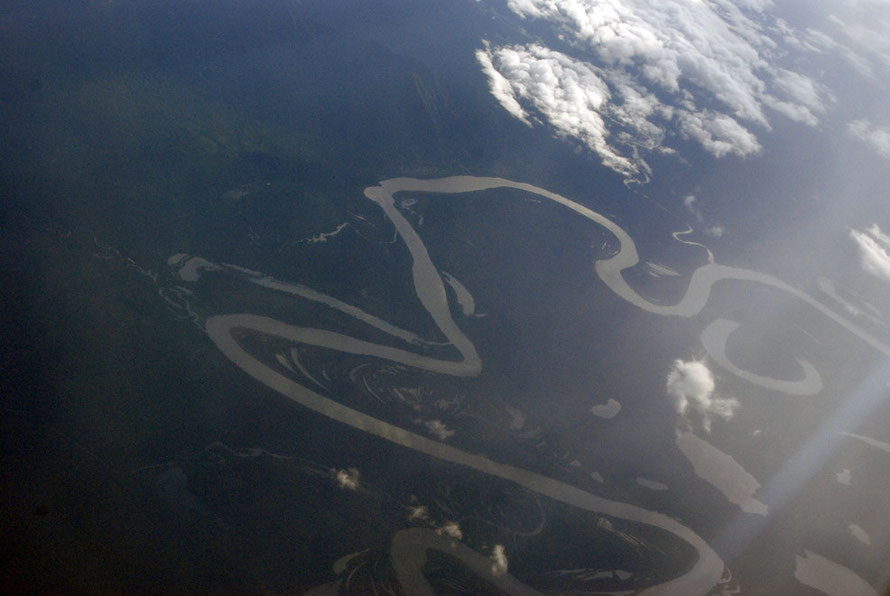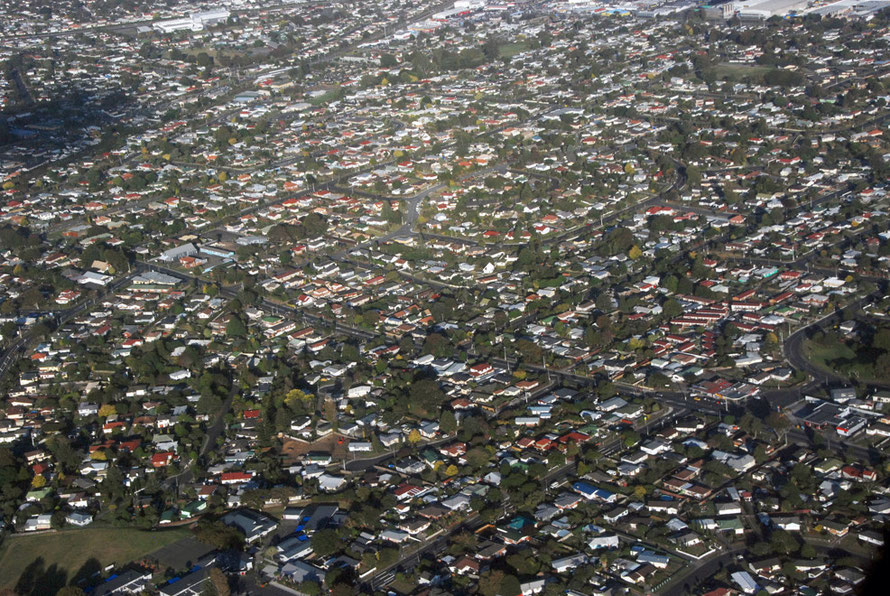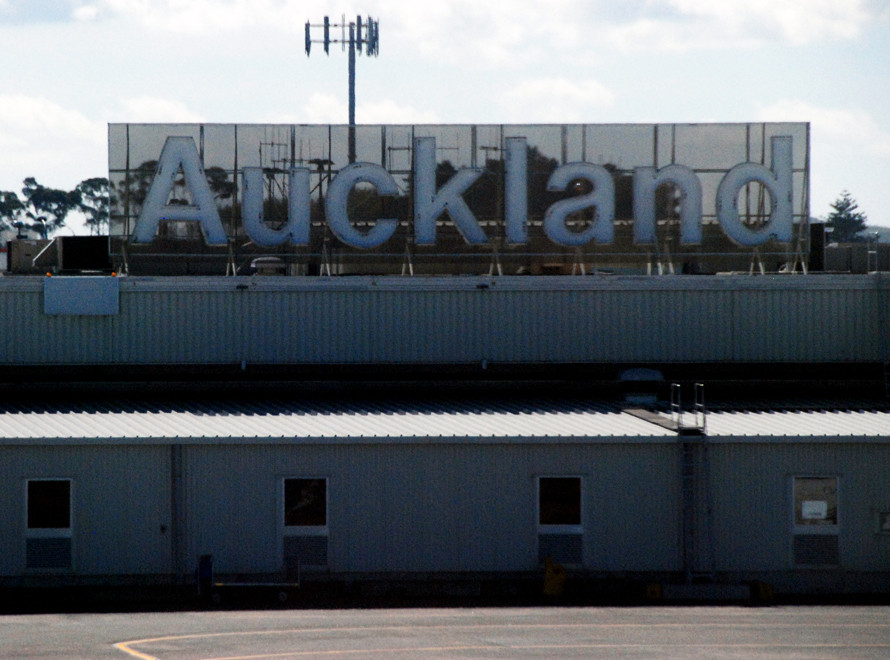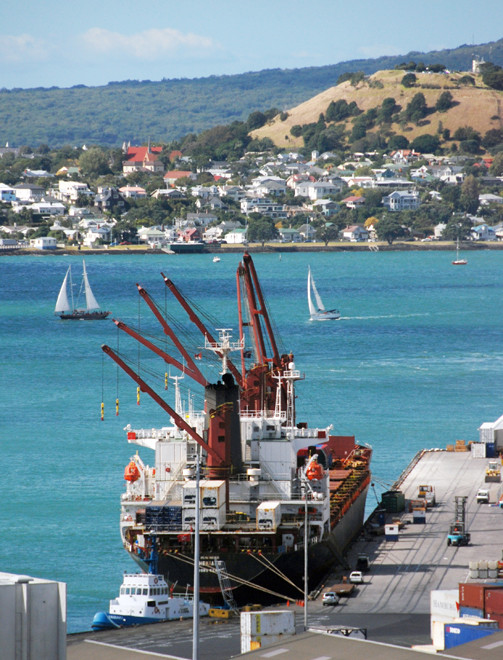The Time Machine: Arriving

After 20 hours of flying there we were, arriving over the Tasman Sea. We’d had a three hour stopover in Hong Kong to drink coffee, watch people from all over the place queuing to get on planes and and walk the incipient thrombosis out of our legs. Ridiculously, given the amount of food we had eaten on the first leg of the flight, we both were hungry. We had Taiwanese noodles at a quieter eating place away from the main foodhall.
Hong Kong was wet and choking in smog from the Pearl River Delta. The sub-tropical night appeared to be falling as we arrived but I‘d already pretty much had it with the concept of time.
‘So’, I’d say, ‘we left Heathrow at 11.00pm and its now 6.00pm and we flew for 10 hours so that makes it …’ and drift away watching people going backwards on the travelator.

Later - much later after we’d flown down over the Philippines, bumped over the Equator, Indonesia and the Banda Sea - I’d watched aghast from the window as we flew over the thrown-out northern arm of Australia from the Bay of Carpentaria to Brisbane. The country below looked malevolent and utterly empty in the stark relief of violet and red hues.
The plane’s flying map told me this was the Great Artesian Basin and it went on and on desolate and magnificent in its nullity. Little did I know that it is the greatest artesian basin in the world and is reckoned to hold some 64,000 cubic kilometres of water.
To me it looked as dry as the proverbial kangaroo’s jockstrap but for the toxic blue-green tailing pools next to the white gash of mining spoil - possibly the long-abandoned Mary Kathleen Uranium Mine.
We flew on and on - the car journey from the Bay of Carpentaria to Brisbane is a 27-hour drive and a distance of 2,046 km (1,271 miles) – until the sun gradually breasted the great curve of The Earth.
The flight seemed to stretch time itself as we flew through thirteen hours of difference colliding with the sun travelling east and moving from early spring across the equator to late summer. Then the vastness of the Tasman Sea lay below us , the ‘ditch’ as she is drolly known in these parts, stretching 2,287km (1,421 miles) between Brisbane and Auckland – and again it just went on and on. The broken fair-weather clouds and ruffled surface of the sea six miles below might have been a loop-film for all it changed.
Sleep had long since deserted me but I endeavored to remain in my cocooned world: ear plugs, eye mask, neck pillow and blanket. I tried to think of the names of every girl and woman I’d ever known. To concentrate on my breathing. To rest.
And then finally and finally after another meal from our delightful Cathay Pacific hosts the western shore of the North Island of New Zealand came into view.
In dazzling, colour-true sunshine we flew south down the coast past ochre dunes, orange beaches and black-grey iron sands, surf pounding brilliantly white, dark forests, and the arching ultramarine sky.
We glided effortlessly from the sprawling, windswept sandhills at Tauroa Point, past the sunken valley systems of Herekino, Whangape, and Hokianga to Dargaville and the leathery waters of the Wairoa estuary and Kaipara Harbour, down along Rangitira and the surf beaches of the Waitakere Ranges (Te Henga, Piha, Karekare and Whatipu) before turning sharply east over the Manukau Habour entrance and Awhitu.
Of course, at the time I didn't know these names but some were to become familiar on my repeated sallies out of Auckland.

We crossed the great sprawl of south Auckland before turning 180 degrees to make our final approach. We skimmed in, air brakes juddering, over Waiheke Island, Tamaki Strait, and the Hunua Ranges – our tightly clasped hands sweating the touchdown - before the ballooning suburbs of Otara and Papatoetoe.
And then, just before we were pitched into the serpentine inlets and mangrove swamps of the west harbour a bold, skid-marked runway appeared and we were down with that little – God-get-it-down pause between the engines being backed and the wheels finally banging onto the good hard concrete of New Zealand.
There followed the banality of airports and the debouchment – ‘the act or an instance of marching [or stumbling] from a narrow, confined area [through the detritus of the achingly spacious Business Class lounge] into the open.’
We wished our Cathay Pacific crew thanks – the agony of waiting over, the anxiety of arriving about to begin.
The passport check was a formality, a blur now, then our unwieldy suitcases rumbling down the carousel, their caustic orange ‘Caution: Heavy’ stickers a sign of our intent to be prepared for all eventualities and any type of electricity socket.
A cute Beagle sniffer-dog and her no-nonsense woman handler came nosing inconsequentially around us. The dog lifted her nose to a woman’s bag. She was asked sternly if she had an apple in the bag. ‘No’, she said, ‘but I did previously have an apple in it but I left it on the plane’ - which seemed to me, in the circumstances, to be playing with fire.
We’d been forewarned that these checks on food and fruit and soil and spores were serious but we had no idea how serious ‘serious’ would turn out to be. We’d thankfully decided to declare our walking shoes to the Ministry of Primary Industries on the requisite docket. We thought we were home and dry but were shunted into a new queue.
I was travel-sweaty, jittery, my circadian rhythms tangled and kinked like 50 metres of garden hose on a frosty night. Scrabbling into my suitcase towered over by serious hiker-types from Germany with proffered Meindl boots, I nearly spilt contents of a personal and embarrassing nature. But all was well.
A uniformed woman asked us where we were from and what brought us to New Zealand. Another woman who inspected the shameful shoes and whipped them away behind a closed, fern-green door (see http://www.biosecurity.govt.nz/).
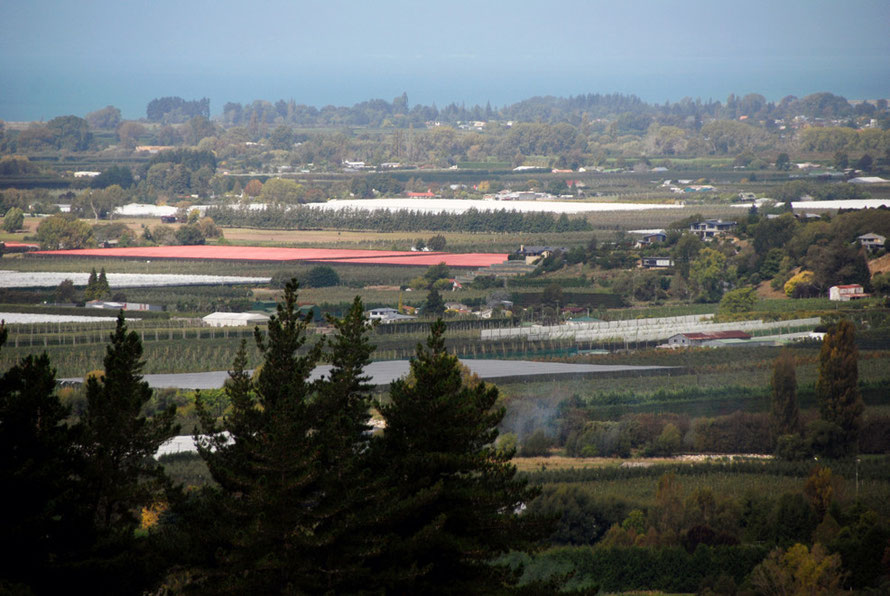
Other passengers were having their dry meat products scrutinized and confiscated. We bided our time and the boots returned in plastic bags, immaculate and warm from their steam scrub.
A final x-ray of our baggage ensued. A fellow traveller butted in ahead of me at the queue excusing herself with a ‘Sorry, I didn’t realize you were waiting.’ As if I could possibly have been standing there for any other reason. I exchanged knowing glances with x-ray-flow-control woman and finally we were done and walking out into the Arrivals Hall.
We heard later through a friend of a woman held incommunicado for three hours at the fruit control for bringing in an orange. She claimed that the delinquent citrus now features in the photo line-up of prohibited items at the airport.
What hell it is to walk past those welcoming smiles of family and friends in the Arrivals Hall. Sad it is not to be met, not to be greeted and fussed over, not to be taken in hand and guided away from the snorting travel beast towards lifts and parking ticket machines and a car that shuts out the all-too public, all-too close world of the inter-inter-continental trans-hemispheric flight.
Our tempers were beginning to fray like nylon rope in a gale. The air was hot, the light piercingly clear. The car-hire transfer minibus arrived in seconds and after more humping of the bloody bags we were on our way.
In no time we stood before our chariot: a worn-looking blue-rinsed Nissan Bluebird with 130,000km on the clock – that’s seven times the Auckland to London run at 18,325km (11,387 miles) a pop.
I thought to myself – except I seemed to say the words out loud, ‘It’s an old man’s car.’ And then more discreetly to myself, ‘I am an old man.’
I hadn’t driven automatic since driving out of Manhattan the year before and had forgotten about the automatic driving rules – like foot on brake to engage ‘Drive.’ We sit there wondering what’s WRONG with the gearshift, why the Aircon WON’T work.
I drive in a haze all the way to the hotel wondering what that little warning triangle on the dash is trying to tell me; oh yes, the parking brake.
The satnav of course takes its time to locate us as if it too is surprised that we are in Auckland, New Zealand and not Bishop Auckland, Northumbria.
But I've already pulled into the traffic to take on my first Kiwi roundabout and after tense moments between us we follow the ‘All Directions’ sign away from the airport.
The aircon is still not working and therefore MUST be broken. I just keep my eyes on the road as the nice lady on the satnav tells me to ‘take the first exit at the next round-A-bout.’
We wiggle through single-storey shopping streets and thicker traffic until we make it to one of the few kilometres of motorway in New Zealand. Even here the speed is limited down to 100km per hour but things go relatively smoothly.
That is, after the ritual ‘Stop and I’ll drive/ Don’t shout at me/I’m not shouting/I’m just tired and trying to focus on the traffic/Well drive better and don't shout’ scenario that seems to accompany hire cars at the end of long flights like stink follows stink.

No sooner are we on the blessed motorway than the nice lady suggests we ‘bear left at the next exit and keep right’ and suddenly we are in narrow streets and surrounded by tall New Zealand buildings.
We go by the brand-spanking-new Auckland Gallery and the alien-looking trees of Albert Park before arriving on a stiff incline at a red light and an instruction to bear right. Another charged exchange ensues as to which ‘right’ the nice lady means – for she surely means ‘Left and then immediately right at the traffic lights’ - until I see the sign for the hotel and its one-nil to me.
But many cars are rammed outside the tiny valet parking bay and what am I to do. I pull up across the throughway of the adjacent much-smarter hotel and sit bewildered as suntanned, shorts-and t-shirt-wearing blokes and girls throw all their road-trip detritus towards the hotel foyer out of a lime green ‘Jucy’ camper van (that comes in Cabana, Condo, Casa and Crib sizes) that blows me a kiss from the pouting, red-haired Marilyn Monroe-esque come-on girl stenciled across its rear.
I get out of the car and ask a guy if this is where we leave the cars and he kind of shrugs and says something like ‘I guess’. I’m berated on return to the Bluebird’s cockpit for assuming-the-guy-is-a-hotel-employee and that-not-all-people-who-look-like-Pacific-Islanders-work-in-hotels and therefore I am a ‘racist’ as well as a bad and bad-tempered driver. So that's one-all then, I guess.
We go through the formalities with the Swedish trainee receptionist with the radiant smile. She’s been in NZ for six months and is just starting a course in Catering and Hotel Management.
Meanwhile there seem to be a load of student-types milling around with twelvepacks of beer and plastic bags of groceries that look set to explode. I’m nursing visions of hell and raucous parties as we wrestle with sleep.
In reality it turns out later that we are the tippy-tappy ones.
‘Always with the walking, stamping around, always walking, I can’t sleep but I trust you, I TRUST YOU’, says the Chinese guy who berates me in my underpants at the hotel room door at 6am two days later. Crouched to hiss through the door crack I explain it’s a carpeted floor, I’m in bare feet, what more can I do? ‘I mean’, I say replaying it later Tony Soprano-wise, ‘What do you want me to do – float?’
‘BUT I TRUST YOU’ he repeats like a mantra, as if I will lose weight or sleep more by its repetition. I will, I say, try and do better, make amends, watch my great clod-hopping Western, Northern hemisphere, post-colonial feet. And in addition not break eggs until his beauty sleep is over.
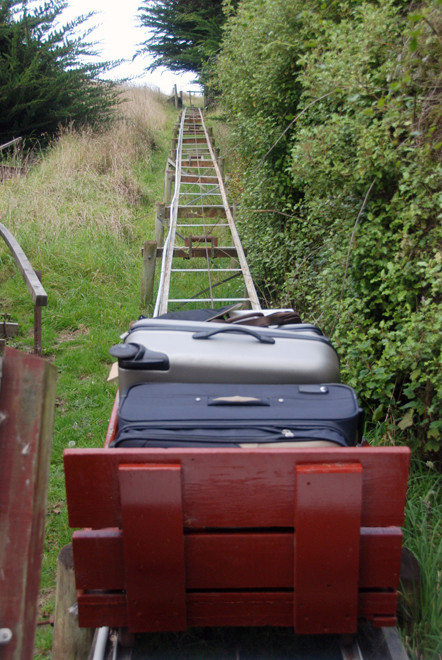
Back in the foyer we struggle the bags down a weird sloping pedestrian flyover.
At the lifts it transpires that one of the three is out of action and that the other two are for the exclusive use of cleaners moving inexplicably large trolleys with inexplicable frequency from the service deck to the upper floors.
But finally, finally, FINALLY we are in our rooms- our apartment with its ‘fully equipped’ kitchen. We take it all in – the galley kitchen , the - what shall we call it? – the reception room? which has what appears to be a leather bus seat appended to the wall, a TV and a tiny two-person patio table and chairs surrounded by an acre of moss-green, rasping carpet.
The bathroom is a moist squeeze – toilet, sink, shower in a coffin arrangement - separated from the sleeping area by an ill-fitting sliding door that sways giddily on its top runner.
But we have a balcony that lets out onto the container port and promises many photographic opportunities.
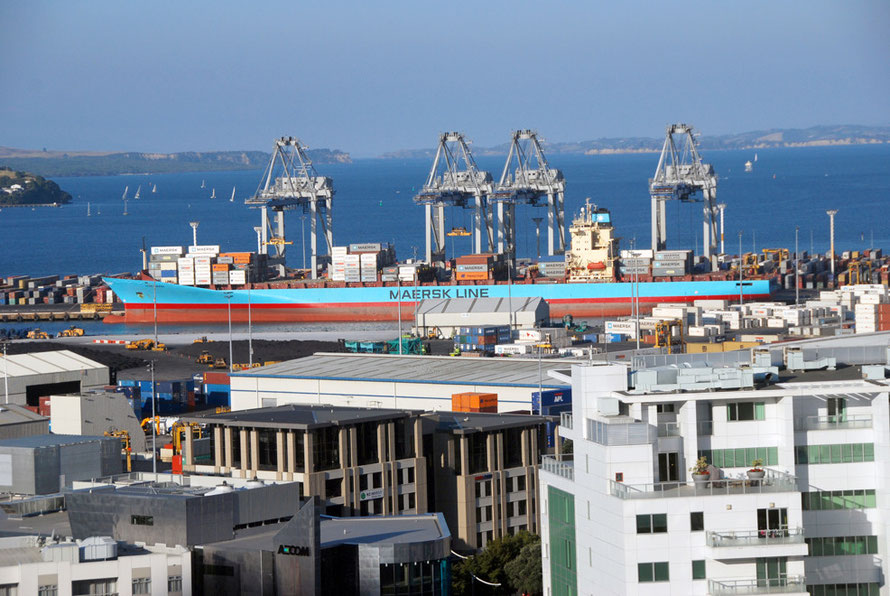
Later I discover a massive insufficiency in the well-equippedness of the kitchen to the extent that on a long foray to the far-flung village of Coromandel on NZ Trip Day 4 I buy a non-stick frying pan and rubber-handled wooden spatula for NZ$55 with the witty entrée – ‘I’ve come all the way from Dover in the UK to your shop to buy a frying pan.’
Outside, the sun shines, the waters of the Waitemata Harbour dazzle, two container ships lie at the Mechanics Bay wharf, gantries work hard, ferries ply to and fro and flashing triangles of dazzling canvas contrast with the turquoise sea and pastel shades of the old Dominion buildings of Devenport across the way.
Hunger and tiredness gnaw at us and the thought of cold, olive-green, crisp white wine dances like a vision of salvation. We abandon our possessions careless of their security and head through the muggy Auckland streets to find a shop. We have, finally, arrived.

